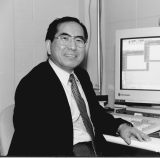|
||||||||||||||||||||||||||||||||||||||||

Hisashi Kobayashi
|
Hisashi KobayashiSherman Fairchild University Professor of Electrical Engineering and Computer SciencePh.D. 1967, Princeton University
Our current research program encompasses the following four areas: (i) coding and modulation applicable to the current and next generation wireless communications, and to high-density digital recording; (ii) architecture and protocol design of all-optical networks; (iii) medium-access control of wireless ATM; and (iv) teletraffic theory. In the area of coding and modulation, we are currently investigating a novel reception scheme that can significanly improve the performance of a "concatenated system" by adopting soft decision and iterative decoding. A concatenated system is more general than a system with concatenated codes: Any connection of an encoder with a modulator with memory and/or a channel with memory will constitute such a system. Applications examples are the following: GSM digital cellular, the pan-European digital cellular, with/without multipath interference, and digital magnetic/optical recording that adopts error-correction coding and partial-response (PR) coding. Our inventions are currently under review by the U.S. Patent Office. We are studying application of the EM (expectation-maximization) algorithm with sequence estimation of continuous phase modulated (CPM) signals received through a time-varying multipath channel. We are also investigating the capability and efficiency of an FM-discriminator-based noncoherent reception of FSK signals, especially GMSK (Gaussian minimum shift keying) signal adopted in GSM. In these studies we use extensively COSSAP simulation models to augment or validate our analysis. Our future effort will expand these studies to "transceiver" designs for third-generation wireless systems with wideband CDMA (W-CDMA). In the second area, we are working on two topics envisioned for future all-optical networks. One is a network architecture as well as signal analysis of Terabit-per-second network (Tbps) that performs coding and modulation in the "spectrum domain." This is a joint effort with Professor Warren S. Warren of chemistry and Professor Paul Prucnal of electrical engineering. We are investigating the spectral-domain CDMA as well as TDMA approach to such an all-optical network design. The second topic is design of a MAC (medium access control) protocol and its performance analysis for a WDMA (wavelength division multiple access)-based multichannel LAN. In the third area, we are analyzing various medium access control (MAC) protocols that can be applied to wireless networks interfaced with an ATM network. We are constructing an OPNET-based simulator for performance analysis. In the area of teletraffic theory we have been working on diffusion approximation (for example, the multidimensional Ornstein-Uhlenbeck process) models applicable to the bandwidth allocation problem for an ATM network. We have also substantially generalized the classical loss system models (that is, Erlang and Engset models) and developed a unified theory for loss-queueing networks. The model will be applicable to connection-oriented network services, including ATM, all-optical networks, and wireless networks. In addition to these research efforts, I am authoring two textbooks based on the lectures I regularly teach: Digital Communications and Networks (ELE 486) and Communication Networks: Modeling and Analysis (ELE 531). |
|||||||||||||||||||||||||||||||||||||||
|
|
|
| Contents copyright © 2002 Princeton University Department of Electrical Engineering All rights reserved. |
|